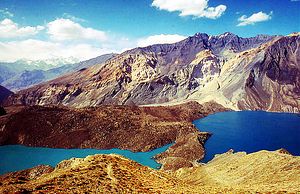Parliamentary elections in Tajikistan have overshadowed the recent commitments by international lenders to finance projects in the country. Both the European Bank for Reconstruction and Development (EBRD) and the Asian Development Bank (ABD) have allocated funds, giving a boost to Tajikistan’s image. Chinese lenders also have turned their eyes towards the mountainous Central Asian country, as Tajikistan may become a crucial node for Beijing’s Silk Road initiative. The West is also focusing on Dushanbe, as it is regarded as a solid garrison from which to engage with Afghanistan and Pakistan to the south.
Indeed, Tajikistan has an important role to play with Afghanistan and Pakistan. Recently, Dushanbe concluded several agreements to export electricity to its southern neighbors under the Dushanbe-sponsored and U.S.-backed CASA-1000 program. Afghanistan received around 1.1 billion kWh in 2014 from Tajikistan alone, a slight increase on the previous year. Under the same umbrella program, Pakistan, separated from Tajikistan by the Wakhan corridor, is supposed to receive more than 5 billion kWh every year. Tajikistan will participate with 70 percent of the supply, while the rest will be sent southbound from Kyrgyzstan. In terms of costs, which rounds up to 1 billion dollars, Tajikistan will finance one quarter out of the total tally.
Tajikistan is interested in becoming a regional hub for electricity trade. The EBRD has recently opened up a program to refurbish the 126 MW Kayrakkum hydroelectric project, operating a dam on the Syr Darya. The 75 million dollar project gathered international consultants to assess both electricity production and climate change issues. The World Bank participates in Tajikistan’s development through important infrastructure projects, such as the Central Asia Road Links program, for which Dushanbe is receiving 45 million dollars. Since 1996, the World Bank has allocated almost 1 billion dollars to aid Tajikistan’s plans. Most importantly, the World Bank is heavily involved in the co-financing of the Rogun dam, a massive hydroelectric project to which citizens of Tajikistan had to subscribe as well.
Other lenders are helping with infrastructure projects. In this respect, Tajikistan plays a crucial role in the common projects of the Chinese government and of ADB. Tajikistan lies at the crossroads of Beijing’s own Silk Road initiative and ADB’s CAREC (Central Asia Regional Economic Cooperation). ADB vice president Zhang Wencai said in an interview that “Large investment needs for infrastructure in the region create large funding gaps,” which in turn create the opportunity for other investors to participate.
The ADB will also assist Tajikistan in the implementation of its five-year plan for 2016-2020, which is focusing on the development of infrastructure (both in the fields of energy and transport infrastructure, access to water, and institutional reform). Tajikistan has been part of the ADB for 17 years, during which time it has received more than 1 billion dollars in loans and grants.
The Chinese government plans large investments in Tajikistan. At the end of February, the Beijing-based Sino-Tajik Mining Company was granted a parliamentary permit by the parliament in Dushanbe to develop the lead deposits in Zarnisori Shimoli for 200 million dollars for the project. The impact on the labor force should result in 2,000 new jobs.
Last January, Tajikistan became a founding member of the Shanghai-based Asian Infrastructure Investment Bank (AIIB). The AIIB is seen as an alternative to the World Bank and the ADB, as its aim is also to provide project loans to developing countries. China will remain AIIB’s majority shareholder.
The interest of the most important institutional lenders, together with the investments from Beijing, suggest that Tajikistan’s geographical position and its water endowment make it an invaluable partner for outside powers who wish to keep the region interconnected. Neighboring Uzbekistan, on the other hand is not happy with Tajikistan’s upstream water management. Spats between Tashkent and Dushanbe are ongoing, but Tajikistan right now is of international interest. Its proximity to the Afghan hotspot might explain both the deep financial involvement and the lack of scrutiny given to its governance.

































